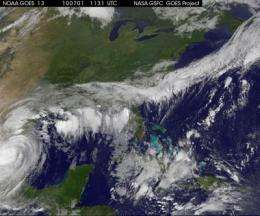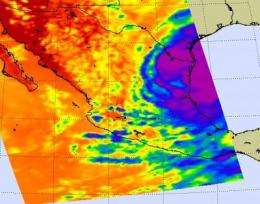GOES-13 satellite catches Alex as a tropical storm now, after a landfall in northeastern Mexico

Alex made landfall at 10 p.m. EDT in northeastern Mexico, about 110 miles south of Brownsville, Texas. By 8 a.m. EDT on July 1, Alex has weakened to a tropical storm and GOES satellite imagery showed it moving near the high mountains of Mexico.
At 8 a.m. EDT on July 1, Alex was about 55 miles (85 km) west of Ciudad Victoria, Mexico. That's near 23.8 North and 99.8 West. Its maximum sustained winds were now around 70 mph (110 km/hr) with higher gusts. Alex is moving west at 12 mph (19 km/hr) and has a minimum central pressure of 977 millibars. The Geostationary Operational Environmental Satellite that covers the U.S. east coast, called GOES-13 captured an image of Alex moving into the Mexican mountains at 1131 UTC (7:31 a.m. EDT).
GOES satellite imagery is created by NASA's GOES Project, located at NASA's Goddard Space Flight Center, Greenbelt, Md. GOES-13 is operated by the National Oceanic and Atmospheric Administration.
The government of Mexico has replaced the hurricane warning with a Tropical storm warning for the coast of Mexico from Rio San Fernando to La Cruz.
NASA's AIRS instrument aboard the Aqua satellite captured Alex on June 30 at 2017 UTC (4:17 p.m. EDT) about 6 hours before Alex's eye made landfall. At that time, the strongest thunderstorms were mostly still offshore and the infrared imagery showed that cloud tops were so high they were colder than -63 Fahrenheit.

When Alex did make landfall, it was packing maximum sustained winds near 97 mph (85 knots) and dumped 8 to 12 inches of rain on northeastern states in Mexico. The National Hurricane Center in Miami, Fla. noted that Alex will continue to be a big rainmaker. Alex is expected to produce total rainfall accumulations of 6 to 12 inches over portions of northeastern Mexico. Isolated maximum amounts of 20 inches are possible over the higher elevations of northeastern Mexico. Alex is expected to produce total rainfall accumulations of 4 to 8 inches over portions of southern Texas, with possible isolated maximum amounts around 10 inches.
In Texas, Galveston and Jamaica Beach, Texas received enough rainfall to cover the roadways last night, but the roads have already cleared this morning. Brownsville, Texas reports no wind damage, no power outages, and clear roadways. Sporadic power outages, a wind gust to 66 mph, and a storm surge of 3.44 feet were reported in South Padre Island, Texas. In Boca Chica, Texas, there was a report of a tornado touchdown at 6:45 p.m. CDT.
The system is now moving inland and weakening. Heavy rainfall is the main threat as Alex continues to weaken. Alex is expected to weaken to a tropical depression later today and dissipate in the next 24 to 36 hours.
Provided by NASA's Goddard Space Flight Center




















